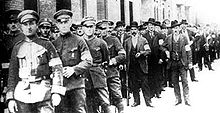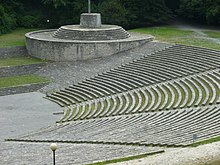Riots in Upper Silesia

The Silesian Uprisings were three armed conflicts 1919-1921 in to Germany belonging Upper Silesia took place. The declared aim of the Polish insurgents was to join Upper Silesia to the newly founded Poland . The insurgents received no open military support from the Polish state, which was at war with Soviet Russia . The division came about and East Upper Silesia was ceded to Poland in 1922. The organizer is Wojciech Korfanty from Upper Silesia , who was appointed Polish plebiscite commissioner by the Warsaw government and who was previously a member of theHad been the German Reichstag .
First uprising - 1919

The first uprising broke out on the night of August 16-17 , 1919 under the leadership of Alfons Zgrzebniok . The occasion was the killing of 10 striking Polish miners from the Myslowitz mine on August 15, 1919. The uprising was triggered by the Polish Military Organization ( POW , Polish Polska Organizacja Wojskowa Górnego Śląska, Polish Military Organization Upper Silesia ) and the Black Reichswehr on August 26, 1919 dejected.
Second uprising - 1920

The second uprising, also led by Alfons Zgrzebniok, broke out on the night of August 19-20, 1920 and lasted until August 25th. It was caused by the Polish-Soviet War and the Battle of Warsaw in 1920 . In anticipation of the conquest of the city by the Red Army , a demonstration took place on August 17, 1920, during which the premises of the Polish plebiscite commissioner were demolished and Polish shops were looted by pro-German demonstrators. Shortly before the outbreak of the second uprising, the Polish MP Józef Rymer was beaten to hospital by German combat troops.
There were acts of violence such as the burning of the village of Anhalt , which is predominantly inhabited by Protestant Germans , and 14 homesteads were set on fire by strangers. A German was killed and another injured in Loslau . Ten harvest workers were killed in an attack near the small village of Josefstal, including some Polish-speaking people from East Prussia . In total, the uprising left at least 35 dead and several hundred injured. The fighting ended at the instigation of the International Commission after the Propolian forces had been granted access to the provisional administration and security forces.
In the second uprising, the special police of the Upper Silesian Self-Protection acted on the German side as a military intelligence force against the Polish military organization POW and its Bojówka Polska (BP).
Third uprising - 1921
The tense security situation, terror and counter- terror in Upper Silesia before and during the referendum in Upper Silesia on March 20, 1921, killed around 3,000 people on both sides. On November 20, 1920, Polish nationalists murdered Theofil Kupka , whom they viewed as a traitor because he had gone from being a companion to becoming head of the Upper Silesian League . But even after the referendum (ratio of votes: 700,605 or 59.6% for Germany, 479,359 or 40.4% for Poland) the situation hardly improved. The tensions culminated in the third uprising, which broke out on the night of May 2nd to 3rd, 1921 and lasted until July 5th, 1921. The Polish government made it very clear that it disapproved of the uprising and dismissed Wojciech Korfanty from the post of plebiscite commissioner.
The third uprising was led by Colonel Count Maciej Mielżyński . The immediate cause was the rejection of the Anglo-Italian territorial division proposal ( Percival - de Marinis line) by the propolian side, who wanted to leave three quarters of Upper Silesia, including all industrial centers , with Germany. A large number of Polish volunteers “who did not live in Silesia” took part. This began the occupation of that part of Upper Silesia which, according to Korfanty's ideas, should be ceded to Poland. Only the Italian troops of the League of Nations prevented the rebels from advancing; the French units did not intervene. Members of the German Freikorps then joined forces in the Self-Protection Upper Silesia (SSOS) and began to defend themselves . The last fighting of the uprising took place in May 1921 in the area around St. Annaberg . The decision was made on May 21, 1921 with the successful storming of Annaberg by the SSOS. The uprising ended on July 5, 1921, under pressure from the Inter-Allied Government and Plebiscite Commission for Upper Silesia, an armistice agreement . Korfanty bowed to this pressure, wanted to see the uprising only as a military manifestation and ordered an end to the fighting. For this he was supported by the military rebellion leadership, among others. sharply criticized by Colonel Mielżyński.
Nevertheless, Korfanty prevailed and was able to celebrate the partition proposal (2/3 Germany, 1/3 Poland) signed at an ambassadors conference in Paris in 1921 as a success of his own.
The Italian soldiers of the Inter-Allied Commission paid for this mission with 19 dead and 34 injured.
Effects
The Versailles Treaty already provided for the possibility of dividing up the area. On October 20, 1921, the conference of ambassadors in Paris decided that the area should be divided up, with the German Empire and Poland each receiving a share according to the election result. Accordingly, the larger, predominantly agricultural western part of Upper Silesia remained with Germany, while the east around Kattowice ( Katowice ) with its valuable coal, iron ore and zinc mines and the majority of processing plants came to Poland.
In Germany, the division led to the resignation of Joseph Wirth's government .
Furthermore, on May 15, 1922, the German-Polish Agreement on Upper Silesia (also known as the Geneva Agreement) was concluded, a bilateral minority agreement concluded between the Republic of Poland and the German Reich . In addition to the protection of minorities, the agreement also regulated the economic conditions in the areas in Upper Silesia that the German Reich had ceded to Poland.
Monuments
Between 1934 and 1936 a so-called " Thingplatz " was built at the foot of the Annaberges according to designs by Böhmer & Petrich . This amphitheater , the first of its kind in Silesia, had 7,000 seats and 20,000 standing places. Between 1936 and 1938, a mausoleum based on a design by Robert Tischler was built on the mountain as a complementary building. The cylinder building made of yellow-brownish limestone in the shape of a knightly fortress temple was accessible through a tour. To the west a staircase led to a mortuary hall carved into the rock with the sarcophagi for fifty dead. In the middle was a sculpture of a dying warrior created by Fritz Schmoll called Eisenwerth . The mausoleum is considered to be an effective implementation of the myths of National Socialism .

In 1945 the building was blown up. A memorial designed by Xawery Dunikowski to commemorate the rebels was erected on the same site until 1955 . Four rectangular pylons surround an eternal fire flaming in the middle. On the walls there are stylized relief drawings of miners, Silesian farmers, a Silesian woman with a child, everyday and work scenes from the present and scenes of the battles between Poles and Germans since the Middle Ages. At the celebration of the 25th anniversary of the third uprising, urns containing the ashes of those who died in the Warsaw uprising were transferred. The monument is not considered Dunikowski's best work as the propaganda aspect dominates the architecture.
literature
- Boris Barth : The Free Corps Battles in Poznan and Upper Silesia 1919–1921. A contribution to the German-Polish conflict after the First World War , in: Dietmar Neutatz / Volker Zimmermann (eds.): The Germans and Eastern Europe. Aspects of a diverse relationship history. Festschrift for Detlef Brandes on his 65th birthday , Munich 2006, pp. 317–333. ISBN 3-89861-629-0 .
- Timothy Wilson: Frontiers of violence. Conflict and identity in Ulster and Upper Silesia 1918–1922 , Oxford University Press, Oxford [u. a.] 2010, ISBN 978-0-19-958371-3 .
- Andreas Kiesewetter: Documents on Italian politics in the Upper Silesian question 1919-1921 , Königshausen & Neumann GmbH, Würzburg 2001, ISBN 3-8260-2035-9 ; Funded by the Federal Ministry of the Interior,
Web links
Individual evidence
- ^ Heinrich Jaenecke : Poland. Dreamers, Heroes, Sacrifice , p. 79, STERN books published by Gruner & Jahr Verlag, Hamburg 1981, ISBN 3-570-00825-8 .
- ^ A b Hans Roos: History of the Polish Nation 1918–1978. P. 91, Kohlhammer, Stuttgart Berlin Cologne Mainz 1979, ISBN 3-17-004932-1 .
- ↑ Karsten Eichner: British, French and Italians in Upper Silesia 1920–1922. The inter-allied government and plebiscite commission in the mirror of the British files (= supplements to the yearbook of the Silesian Friedrich-Wilhelms-Universität zu Breslau; vol. 13), Scripta Mercaturae Verlag, St. Katharinen 2002, p. 100; Guido Wärme : Carl Ulitzka (1873-1953), or, Upper Silesia between the World Wars . Droste, Düsseldorf 2002, p. 305.
- ↑ For Korfanty speech on May 3, 1921: "Rząd polski odwołał mnie ze stanowiska komisarza plebiscytowego never ponieważ byłem w stanie zapobiec puczowi." ( The Polish government called me from the Plebiszitkommissarposten off because I was not able to coup to prevent ) Source: Sigmund Karski: Albert (Wojciech) Korfanty. A biography.
- ↑ § 5. After the end of the vote, the committee informs the main Allied and Associated Powers of the number of votes specified in each municipality and at the same time submits a detailed report on the election process and a proposal on the line to be used in Upper Silesia, taking into account both the expression of will the inhabitants as well as the geographical and economic position of the localities should be taken as the border of Germany. Annex VIII to the Versailles Treaty, concerning § 88
- ↑ Janusz Dobesz: Dealing with the architectural and art heritage as a mirror of the Polish-German and Polish-Russian relationship history. In: Arnold Bartetzky, Marina Dmitrieva and Stefan Troebst (eds.). New states, new images? Visual culture in the service of state self-representation in Central and Eastern Europe since 1918. Böhlau, Cologne 2005, ISBN 978-3-412-14704-4 (= Visuelle Geschichtskultur . 1), pp. 304f .; Juliane Haubold: The peak of symbolism. The Sankt Annaberg as the embodiment of Upper Silesia. In: Peter Oliver Loew, Christian Pletzing and Thomas Serrier (eds.). Recovered history. For appropriating the past in the interstices of Central Europe. Harrassowitz, Wiesbaden 2006, ISBN 978-3-447-05297-9 (= publications of the German Poland Institute Darmstadt . 22), p. 350.
- ↑ Janusz Dobesz: Dealing with the architectural and art heritage as a mirror of the Polish-German and Polish-Russian relationship history. In: Arnold Bartetzky, Marina Dmitrieva and Stefan Troebst (eds.). New states, new images? Visual culture in the service of state self-representation in Central and Eastern Europe since 1918. Böhlau, Cologne 2005, ISBN 978-3-412-14704-4 ( Visuelle Geschichtskultur . 1), pp. 304f.
- ↑ Janusz Dobesz: Dealing with the architectural and art heritage as a mirror of the Polish-German and Polish-Russian relationship history. In: Arnold Bartetzky, Marina Dmitrieva and Stefan Troebst (eds.). New states, new images? Visual culture in the service of state self-representation in Central and Eastern Europe since 1918. Böhlau, Cologne 2005, ISBN 978-3-412-147044 ( Visuelle Geschichtskultur . 1), p. 305.
- ↑ Juliane Haubold: The peak of symbolism. The Sankt Annaberg as the embodiment of Upper Silesia. In: Peter Oliver Loew, Christian Pletzing and Thomas Serrier (eds.). Recovered history. For appropriating the past in the interstices of Central Europe. Harrassowitz, Wiesbaden 2006, ISBN 978-3-447-05297-9 ( publications of the German Poland Institute Darmstadt . 22), p. 361.
- ↑ Janusz Dobesz: Dealing with the architectural and art heritage as a mirror of the Polish-German and Polish-Russian relationship history. In: Arnold Bartetzky, Marina Dmitrieva and Stefan Troebst (eds.). New states, new images? Visual culture in the service of state self-representation in Central and Eastern Europe since 1918. Böhlau, Cologne 2005, ISBN 978-3-412-14704-4 ( Visuelle Geschichtskultur . 1), pp. 305f.
- ^ Andreas Kiesewetter: Italy and Upper Silesia 1919-1922: Documents on Italian Politics ... , pp. 41,62.



